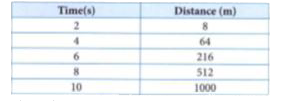Assertion: For applying the second law of motion, there is no conceptual distinction between inanimate and animate objects.
Reason: An animate object requires an external force to acceleration.
If both assertion and reason are true and reason is the correct explanation of assertion.
If both assertion and reason are true and reason is the not correct explanation of assertion.
If assertion is true but reason is false
If both assertion and reason are false.
The correct Answer is:B
Second law of motion can be applied to both inanimate and animate objects. An animate object such as a human also requires an external force to accelerate. For example, without the external force of friction, we cannot walk on the ground.
Topper's Solved these Questions
- LAWS OF MOTIONBOOK - NCERT FINGERTIPSCHAPTER - LAWS OF MOTIONEXERCISE - NCERT Exemplar
9 Videos
- KINETIC THEORYBOOK - NCERT FINGERTIPSCHAPTER - KINETIC THEORYEXERCISE - Assertion And Reason
10 Videos
- MECHANICAL PROPERTIES OF FLUIDSBOOK - NCERT FINGERTIPSCHAPTER - MECHANICAL PROPERTIES OF FLUIDSEXERCISE - Assertion And Reason
15 Videos
Similar Questions
Knowledge Check
Assertion: Friction depends on the weight of the object
Reason: A heavier object exerts a greater frictional forceAIf both assertion and reason are true and reason is the correct explanation of assertionBIf oth assertion and reason are true but reason is not the correct explanation of assertionCIf assertion is true but reason is falseDIf both assertion and reason are falseAssertion: Force is always in the direction of motion.
Reason: In every case force is not parallel to acceleration.AIf both assertion and reason are true and reason is not the correct explaination of assertion.BIf both assertion and reason are ture but reason is not the correct explanation of assertion.CIf assertion is ture but reason is false.DIf both assertion and reason are false.Assertion : For a free falling object, the next external force is just the weight of the object .
Reason : In this case the downward acceleration of the object is equal to the acceleration due to gravity.AIf both assertion and reason are true and reason is the correct explanation of assertionBIf both assertion and reason are truebut reason is not the correct explanation of assertionCIf assertion is true but reason is falseDIf both assertion and reason are false.
Assertion (A): Euglena is a connecting link between plants and animals.
Reason (R): Euglena is a unicellular eukaryote
View SolutionAccording to the Second Law of Motion, for a given force, acceleration is Inversely pro-portional to the of an object.
View SolutionAssertion : The gravitational force makes the earth move around the sun and also makes the moon go around the earth.
Reason : Every objects in the universe exert a force on other objects.
View SolutionWhen a body is moving uniformly along a straight line and there is no force of friction, acceleration/retardation of the body. According to Newton's second law of motion, the magnitude of force acting on a body is the product of mass and acceleration of the body
The distance - time table of an object in motion is given below

In the given table, acceleration of the object is
View SolutionWhen a body is moving uniformly along a straight line and there is no force of friction, acceleration/retardation of the body. According to Newton's second law of motion, the magnitude of force acting on a body is the product of mass and acceleration of the body
The distance - time table of an object in motion is given below

The force acting on the object
View Solution
